迈向 TiO2 纳米流体——第 2 部分:应用和挑战
摘要
由于纳米流体在能量系统应用(例如太阳能集热器、制冷、热管和能量存储)中在热量或质量传输、流动性和分散稳定性方面的迷人特性,对纳米流体的研究呈爆炸式增长。综述的第二部分总结了最近关于 TiO2 纳米流体应用的研究,并确定了进一步探索 TiO2 纳米流体的挑战和机遇。预计这两篇详尽的综述可为研究人员更新TiO2纳米流体的研究现状提供有益的参考指南,批评性评论、挑战和建议对未来的研究方向有所帮助。
评论
背景
第一部分综述了其制备、稳定性和性能方面的研究。可见,在纳米流体的制备方向和性质方面已经开展了很多研究[1,2,3,4,5,6,7]。同时,对于纳米流体的应用也进行了很多尝试,尤其是在能源系统中[8,9,10,11]。由于传热传质过程的增强,TiO2纳米流体已初步应用于太阳能集热器[12]、制冷[13,14,16]、储能[17、18]、热管[19,20]等领域。 ,21],以及其他能源应用[22,23,24,25,26,27,28,29,30,31,32,33,34],如汽车散热器[31],PV/T混合系统[ 32, 33] 和热电联产 (CHP) 系统 [34]。在我们之前的研究中,已经总结了 TiO2 纳米流体在热传导、强制对流沸腾传热和自然对流传热方面的传热特性 [35]。然而,对于TiO2纳米流体的应用还远没有一个全面的总结; TiO2 纳米流体也有许多实际应用。在这里,在第 2 部分中,我们将详细回顾 TiO2 纳米流体的热导率和与能量相关的应用。我们希望这两篇综述结合我们之前的报告 [35] 可以对 TiO2 纳米流体的研究进展提供一个全面的了解。随着纳米流体技术的发展,纳米流体有望作为一种新型高效的工作流体在这些能源系统中得到实际应用。
在提高热导率方面的应用
由于纳米流体的优异性能通常归因于添加纳米粒子的流体的物理性质,因此对纳米流体热导率的实验或理论研究应该是纳米流体领域的一个重要课题。虽然大多数评论文章在物理性质部分介绍了导热系数,但提高导热系数也是纳米流体的一个重要应用方面。另一个将热导放在应用部分的原因是为了平衡两篇评论的内容。
许多实验和理论研究结果表明,纳米颗粒的加入可以明显提高流体的热导率。影响纳米流体热导率的因素可以归纳为以下几组:(1)内部因素,包括颗粒的类型、含量[36、37]、尺寸[38]、形状[39]和结构[40]和基液类型 [41] 和可能的表面活性剂或 pH 调节剂 [42, 43] 如果有的话; (2)外部因素,包括温度[40]、超音速振动时间[44]、储存时间[45]或运行时间[46]; (3)微观因素,如纳米粒子的表面电荷状态[47]、粒子簇[48]、界面纳米层[49]、布朗运动[50]、聚集[51]、界面热阻和质量差异散射[52]。我们之前的研究提供了一个表格来显示 TiO2 纳米流体的热导率 [35]。然而,了解不同的影响因素对影响程度的影响并不直观,也不方便。因此,在这部分2中,通过图表展示了对TiO2纳米流体热导率的影响,以提供更直观的理解。
粒子加载效果
现有文献中TiO2-水纳米流体热导率随纳米颗粒体积分数增加的总结如图1所示。从所有实验结果可以看出,TiO2纳米颗粒可以提高基液的热导率。然而,不同研究的增量是截然不同的。例如,纳米流体热导率的一种增强是 TiO2 纳米颗粒体积负载的 2-4 倍,包括 Masuda 等人。 [53],图尔古特等人。 [54],张等人。 [55],王等人。 [56]、Pak 和 Cho [57]、Yang 等人。 [58] 和 Mushed 等人的 [59] 结果。另一种增强可以达到 TiO2 纳米粒子体积负载的 6-20 倍,包括 Yoo 等人。 [60],文和丁 [61],穆谢德等。 [62],何等人。 [63],陈等人。 [64] 和 Saleh 等人的 [65] 结果。
<图片>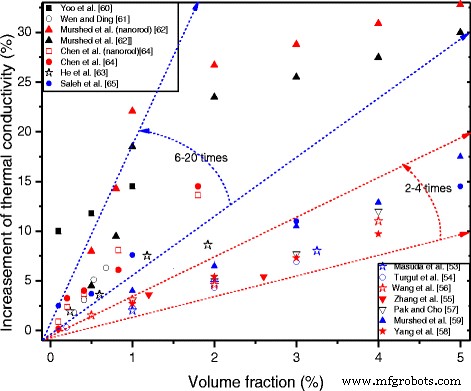
现有文献中TiO2-水纳米流体热导率的体积分数依赖性
结果的差异可能是由于,除了体积分数外,TiO2 纳米流体的热导率还取决于颗粒的参数和环境条件,如颗粒大小和形状、表面活性剂、pH 值和温度,这在不同的作品中是完全不同的。此外,一些研究人员观察到,纳米颗粒对 TiO2 纳米流体的热导率几乎没有影响。 Utomo 等人。 [66] 研究了水基氧化铝和二氧化钛纳米流体的热导率。他们观察到,由于分散剂含量高,他们制备的 TiO2 纳米流体的热导率略低于传统模型预测。结果清楚地表明,TiO2纳米流体在管流中没有表现出异常的热导率增强或对流传热系数,如其他报道所示。
粒子形状效果
纳米颗粒的形状和尺寸的影响不像颗粒负载的影响那么广泛。现有的研究没有显示出颗粒形状或尺寸对 TiO2 纳米流体的热导率有很大影响,这很可能是由于这种影响的数量相对较少。默谢德等人。 [62]使用CTAB作为分散剂分散了两种TiO2纳米粒子水。一种是棒状的,直径乘长为 10 nm × 40 nm。另一种是直径为 15 纳米的球形。他们观察到,两种 TiO2 纳米流体的热导率都随着颗粒负载量的增加而增加,而棒状颗粒比球状颗粒的贡献更大。前者和后者的热导率的最大提高分别约为 33% 和 30%。陈等人。 [64] 分别以水和 EG 为基液,研究了由 TiO2 纳米颗粒(25 nm)和 TiO2 纳米管(10 nm × 100 nm)正交制成的四种类型的纳米流体的有效热导率。他们发现TiO2纳米颗粒和TiO2纳米管对热导率的增强差异不大,但增强程度远大于Hamilton-Crosser方程的计算值。
温度效应
温度是影响 TiO2 纳米流体热导率的另一个重要因素。图 2 显示了不同研究中温度对 TiO2 纳米流体热导率增强的影响。王等人。 [67] 研究了粒子负载和温度对水基 TiO2 纳米流体热导率的影响。结果表明,在较高温度下,工作温度起着更重要的积极作用,对热导率的贡献更大。他们还得出结论,结果与通过考虑与温度相关的布朗运动和微对流确定的理论值一致。雷迪等人。 [68] 研究了不同温度下 0.2-1.0% 范围内不同颗粒负载的 TiO2 纳米流体的热导率。他们观察到 TiO2 纳米流体的热导率随着颗粒负载和温度的增加而增加。杨等人。 [58] 将 TiO2 纳米粒子添加到氨水中以制备基于二元流体的纳米流体。他们还发现,温度升高会导致二元TiO2纳米流体与基液的热导率比增加。
<图片>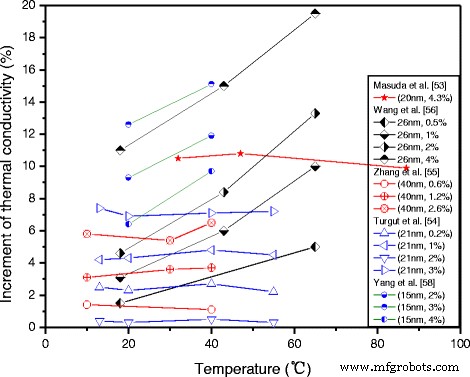
不同研究温度对TiO2纳米流体导热系数增强的影响
以上结果表明,TiO2纳米颗粒在较高温度下对TiO2纳米流体的热导率有更大的贡献。然而,也可以包括一些关于温度影响的奇异结果。图尔古特等人。 [54] 研究了去离子水基 TiO2 纳米流体在 13、23、40 和 55°C 温度下的有效热导率。他们观察到热导率随着颗粒负载的增加而增加,但温度的变化对 TiO2 纳米流体的有效热导率几乎没有影响。此外,一些结果表明温度对有效热导率有影响。 Duangthongsuk 和 Wongwises [69] 将 TiO2 纳米颗粒悬浮在水中,体积负载范围为 0.2% 至 2%,他们在 15 至 35°C 的温度范围内收集数据。他们观察到 TiO2-水纳米流体的热导率随颗粒负载和温度的增加而增加,但热导率比随着温度的增加而降低;他们将原因归结为基液热导率增长较快。
温度对TiO2纳米流体热导率的作用不确定的原因可能是由于纳米流体的热导率机制复杂。当温度变化时,其他参数,如颗粒的结构、表面活性、稳定性和分散剂的特性等可能会发生变化,这些参数在不同的工作中通常会有很大差异。因此,温度对TiO2纳米流体热导率的影响与具体的纳米颗粒和基液类型有关。 Cabaleiro 等人的研究 [41] 进一步改进了这一观察结果,其中分别研究了以乙二醇和丙二醇为基液的锐钛矿和金红石 TiO2 纳米流体的温度依赖性热导行为。这四种 TiO2 纳米流体的热导率的温度依赖性如图 3 所示。可以观察到,四种纳米流体都表现出比相应基液更高的热导率。温度对含有不同纳米晶体结构纳米颗粒和不同基液的 TiO2 纳米流体起到不同的作用。 EG基纳米流体的热导率随着温度的升高而增加,在研究范围内随着温度的升高最大增加了11.4%,而PG基纳米流体的热导率几乎与温度无关。
<图片>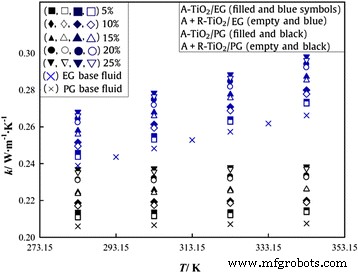
四种 TiO2 纳米流体的热导率的温度依赖性 [41]。经爱思唯尔许可转载
基础流体效果
基础流体的成分也会影响 TiO2 纳米流体的热导率。陈等人。 [64] 分别以水和乙二醇为基液测量了球形和管状 TiO2 纳米流体的有效热导率。他们观察到,以 EG 为基液的 TiO2 纳米颗粒和 TiO2 纳米管的增强效果均高于以水为基液的增强效果。雷迪等人。 [68] 发现水基、EG/W (40%:60%) 基和 EG/W (50%:50%) 基 TiO2 纳米流体的热导率增强从 0.649 增加到 5.01%、1.94当 TiO2 纳米粒子的体积浓度在室温(30°C)下从 0.2% 增加到 1.0% 时,分别增加到 4.38% 和 10.64% 到 14.2%。然而,也可以观察到一些相反的结果,Cabaleiro 等人。 [41] 发现以 EG、PG 或石蜡油为基液的 TiO2 纳米流体的热导率增强明显低于以水为基液的纳米流体。此外,在 Sonawane 等人的报告 [70] 中,基础流体的影响被认为是复杂且难以实现的,因为 1 vol.% 颗粒负载的 TiO2 纳米流体的热导率遵循以下顺序:石蜡油基纳米流体> 水基纳米流体> EG 纳米流体,而纯基流体的顺序为水> EG> 石蜡油。他们从粘度效应的角度分析了这种不稳定的观察结果,认为较低的基液粘度对提高纳米流体的热导率有更大的贡献。
表面活性剂效果
表面活性剂的加入是影响 TiO2 纳米流体热导率的另一个重要因素。一些结果表明表面活性剂对热导率有积极影响。 Saleh 等 [65] 研究了不同类型表面活性剂对 TiO2-水纳米流体热导率的影响,结果如图 4 所示,可以看出三种表面活性剂均能大大提高了纳米流体的热导率,以SDS为稳定剂的纳米流体表现出最大的提高,其次是以CTAB和Span-80为稳定剂的纳米流体。他们认为颗粒的分散稳定性和表面性质与纳米流体热传导的增强有关。
<图片>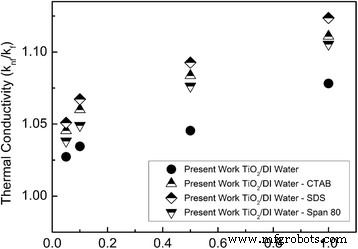
不同表面活性剂对TiO2-水纳米流体热导率的影响[65]。经爱思唯尔许可转载
关于表面活性剂的作用也有一些不同的结果。杨等人。 [58]发现当基液中氨含量增加时,TiO2纳米流体的热导率比也会增加,因为TiO2氨-水纳米流体的稳定性在较高的pH值下会提高。而低浓度的表面活性剂PEG1000和PAA对导热系数的影响相对较小,如颗粒或氨含量、温度等。然而,PEG1000 可以提高 TiO2 氨水纳米流体的稳定性,从而提高纳米流体的热导率。默谢德等人。 [62] 发现油酸和 CTAB 可以提高 TiO2 纳米流体的分散稳定性,而不影响纳米流体的热物理性质和单相传热系数,因为在他们的实验中使用的表面活性剂含量非常低。 0.01–0.02 体积%。也有一些结果表明表面活性剂具有抑制作用。 Utomo 等人。 [66] 研究了水基 Al2O3 和 TiO2 纳米流体的热导率。他们发现稳定剂的高负载量会导致这两种纳米流体的有效热导率降低。
声波效果
超声处理还显示出对 TiO2 纳米流体的热导率的一些影响。伊斯梅等人。 [71] 发现当 pH 值接近 7 时,TiO2-水纳米流体的热导率达到最大值,并通过 2 小时的超声处理进一步提高。他们认为聚合可以解释由于渗透效应所观察到的增强。索纳瓦尼等人。 [70] 对超声波时间对热导率的影响进行了特别研究,结果如图 5a-c 所示。可以发现,对于不同浓度的三种纳米流体,导热系数的增加比例随着超声时间的增加先增加后减小,最大增加出现在超声时间为60 min。他们将原因归结为:60 分钟的最佳超声处理时间可以加强纳米粒子的布朗运动以及粒子与本体液体之间的分子间相互作用,从而提高热导率。然而,超过60分钟的长时间超声会导致纳米颗粒的聚集和聚集,这被认为是纳米颗粒传热和导热率下降的原因。
<图片>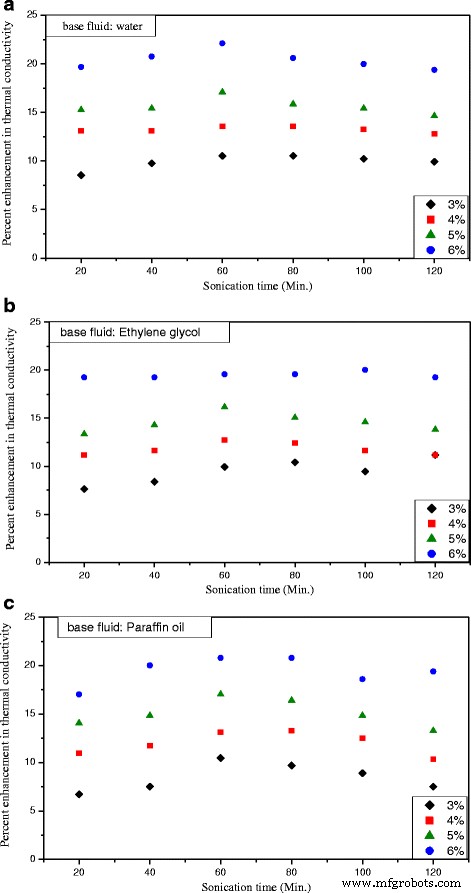
作为超声处理时间函数的热导率增加百分比。 一 基液:水。 b 基液:乙二醇。 c 基液:石蜡油。根据参考文献[70]中的实验数据重新绘制
理论研究
纳米流体的理论研究是纳米流体领域的研究热点之一。近年来提出了许多热导率模型。一般认为,除非有特殊限制,大多数常规模型都可以用于 TiO2 纳米流体。然而,由于TiO2纳米流体的热导率实验数据差异很大,单一模型几乎不可能拟合所有不同的结果。由于传统模型难以应用于个别案例,近年来也提出了一些针对TiO2纳米流体的有针对性的热导率模型。表 1 汇总了专门用于 TiO2 纳米流体的可用热导率模型方程。可以看出,一些模型已经考虑了界面层[59, 72]、布朗运动[73, 74]、粒度和纵横比[72, 75]、聚集[76]等因素。也有一些模型只是通过实验拟合或方差分析提出的 [68, 74, 77,78,79,80,81,82]。可以得出结论,这些模型仅适用于它们的个别情况。尽管对纳米流体热导率的理论研究有了很大的发展,但最根本的缺陷在于不同的实验结果存在很大差异。由于粒子的纳米结构和微运动难以定量描述,因此很难全面准确地掌握纳米流体中的热传导过程。因此,由于模型对于单个应用案例的准确性较差,因此获得纳米流体导热系数用于设计应用系统的最佳方式是进行初步实验。
上述分析表明,目前对TiO2纳米流体热导率的影响因素仍存在争议和不一致。尽管颗粒负载量与纳米流体的热导率呈正相关,但颗粒形状、尺寸、基液类型、温度、表面活性剂和超声处理等其他因素的影响是统一的。即使对于颗粒负载效应,不同样品的热导率增长强度也有很大差异。纳米流体热导率在各种研究中的不一致主要是因为纳米流体的热导率同时受到多种因素的影响,特别是一些微观参数,如粒子团聚和微动等,难以定量分析或测量。
另一个争议是纳米流体热传导增强的机制。粒子聚集和聚集被认为是纳米流体热传导增强的原因 [48, 50, 51]。然而,通过合适的表面活性剂或超声处理具有较少聚集的稳定纳米流体也显示出更高的热导率 [62, 65, 66, 70, 71]。纳米流体热传导增强的主要机制是粒子的聚集或微动,或其他一些需要进一步分析的因素。
太阳能吸收
作为一种清洁的可再生能源,太阳能对环境的影响最小。然而,太阳能集热器的发展受到传统工作流体吸收性能差的限制。因此,近年来,纳米流体技术逐渐应用于太阳能集热器,以产生优异的热学和光学性能。预计这种新一代传热和太阳能吸收液可以提高太阳能的利用效率。
如图 6 所示,在 Khullar 等人的报告中可以观察到基于纳米流体的聚光太阳能热水系统的典型示意图 [83]。他们认为,实施基于纳米流体的聚光太阳能集热器可以实现大量的减排和节能。查吉等人。 [84] 研究了颗粒含量和液体流速对使用 TiO2 纳米流体的小型平板集热器效率的影响。他们发现,与基于欧洲标准 EN12975-2 的基础流体相比,使用 TiO2 纳米流体的收集器效率指数提高了 2.6% 至 7%。赛义德等人。 [85] 使用 TiO2-H2O 纳米流体作为工作流体来提高平板太阳能集热器的性能。他们观察到制备的纳米流体可以保持稳定超过 1 个月。结果表明,与水基液相比,能量效率可提高 76.6 vol.% 负载和 0.5 kg/min 流量,在这些工况下可达到 16.9% 的最高火用效率。
<图片>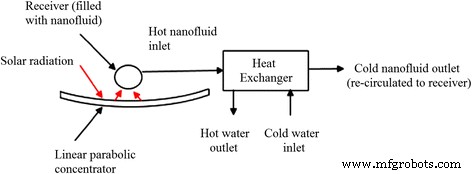
基于纳米流体的聚光太阳能热水系统示意图。根据参考文献[83]重新绘制
近年来,关于使用纳米流体的太阳能集热器性能的理论研究也得到了发展。阿利姆等人。 [86] 从理论上研究了层流下平板太阳能集热器中 Al2O3、CuO、SiO2 和 TiO2 纳米流体的熵产生、传热特性和压降。他们发现各种纳米流体都可以提高性能,而摩擦系数几乎与水基流体相似。法扎尔等人。 [87] 还对这四种纳米流体在太阳能集热器中的性能进行了数值研究。他们观察到,四种纳米流体的节能效果均超过20%,可实现温室气体减排。
纳米流体在太阳能集热器中的性能增强通常归因于两个主要因素:增强的传热特性和光学特性。因此,研究人员还研究了纳米流体在太阳能吸收系统中的光学特性。赛义德等人。 [88] 对 TiO2 和 Al2O3 纳米流体的太阳能吸收性能进行了实验和分析研究。他们使用 0.1 到 0.3 vol.% 的两种体积分数进行光敏性能研究。在他们的分析分析中采用了一些经典理论,包括瑞利、麦克斯韦-加内特和兰伯特-比尔的方法。他们得出结论,在可见光范围内,对于所有粒子负载,TiO2 纳米流体的光学性能均高于 Al2O3 纳米流体。他等人。 [89] 比较了真空管太阳能集热器中 TiO2-水和 CNT-水纳米流体在晴天和阴天条件下的光热转换效率。他们观察到CNT-水纳米流体的温度增量高于TiO2-水纳米流体,表明前者的光热转换特性优于后者。
赛义德等人。 [90] 认为大多数研究都集中在纳米流体的基本热物理和光学特性上;很少有关于散射和吸收的一些重要因素,包括粒径、形状和含量以及基液类型的研究。为了检验这些因素,他们进行了相关研究,观察到粒径在 20 nm 以下时几乎没有影响,并且颗粒含量与消光系数成正比。对于含有 20 nm TiO2 纳米粒子的纳米流体,对于 200 到 300 nm 的波长范围的透射率几乎为零,但对于 400 nm 和 900 nm 分别为 71% 和 88%。他们还建议TiO2纳米颗粒的体积分数应在0.1%以下,这样才能获得更好的结果。
金等人。 [91] 使用 MWCNT、Al2O3、CuO、SiO2 和 TiO2 纳米流体和 PG(丙二醇)-水(20:80)基液在高温 U 型管太阳能集热器中进行了详细的理论研究。他们观察到太阳能集热器的集热器效率与添加的纳米粒子的热导率呈明显正相关,因为它的顺序是从最大到最小:MWCNT、CuO、Al2O3、TiO2 和 SiO2 纳米流体。他们还分析了全球二氧化碳和二氧化硫的减排量以及电力和能源消耗量。他们的研究结果支持纳米流体具有巨大的节能减排潜力。由于他们的理论结果没有考虑不同纳米流体的分散情况,实际性能有待实验验证。
巧合的是,Verma 等人对使用不同纳米流体的平板太阳能集热器进行了类似的实验研究。 [92]。实验结果表明,对于仅 0.75% 的颗粒体积负载和 0.025 kg/s 的流速,纳米流体的火用效率与水相比分别提高了 29.32、21.46、16.67、10.86、6.97 和 5.74%,对于石墨烯、CuO、Al2O3、TiO2 和 SiO2 纳米流体。此外,熵生成的下降遵循这个顺序。他们的研究结果还支持太阳能集热器效率与添加纳米颗粒的热导率呈正相关。
然而,也有一些研究给出了不同的结果。马希安等人。 [93] 分别使用四种不同的水纳米流体与 Cu、Al2O3、TiO2 和 SiO2 纳米粒子分析了基于微通道的太阳能集热器的性能。他们的结果表明,Al2O3 纳米流体表现出最高的传热系数,而最低值属于 SiO2-水纳米流体,但出口温度遵循以下顺序:Cu> TiO2> Al2O3> SiO2 纳米流体。他们还观察到,尽管TiO2-水的热导率低于后者,但TiO2-水的熵生成低于Al2O3-水纳米流体。
制冷
纳米制冷剂是一种特殊的纳米流体,由纳米颗粒和制冷剂以及可能的润滑剂组成。纳米制冷剂是用于压缩或吸收式制冷、空调系统、热泵等的新一代制冷剂。 近年来,许多关于纳米制冷剂的研究表明,在制冷剂或润滑剂中加入纳米颗粒可以实现更好的系统性能和能源效率。
表 2 显示了基于 TiO2 纳米颗粒的纳米制冷剂的相关研究总结。可见,TiO2纳米颗粒与R134a、R600a、R436a、R436b、R141b、R123、R12、R22、R410a等多种制冷剂均能正常安全地工作。可以看出,大多数结果表明,添加TiO2纳米颗粒可以为制冷系统和润滑油系统带来好处,如提高性能[94]、降低能耗[95,96,97]和不可逆性[95,96,97]。 98]。此外,一些研究侧重于纳米制冷剂系统的传热 [99, 100] 和压降 [101],以研究纳米颗粒的作用机制。李等人。 [102] investigated the coefficient of performance (COP) of the refrigeration system for both the cooling cycle and heating cycle, and the results showed that adding TiO2 nanoparticle would lead to a slight decrease in COP of the cooling cycle but a significant increase in COP of the heating cycle based on the power consumption of the compression. Bi et al. [96] experimentally investigated the reliability and performance of a domestic refrigerator with HFC134a as refrigerant and Mineral oil with TiO2 nanoparticles mixtures as lubricant. As illustrated in Fig. 7, the system main consists of fresh food storage room and frozen food storage room as well as refrigeration system pipelines. The results showed that the system TiO2 nanoparticles works normally and safely and adding 0.1 wt.% TiO2 nanoparticles can reduce 26.1% energy consumption while particle type has little effect on performance.
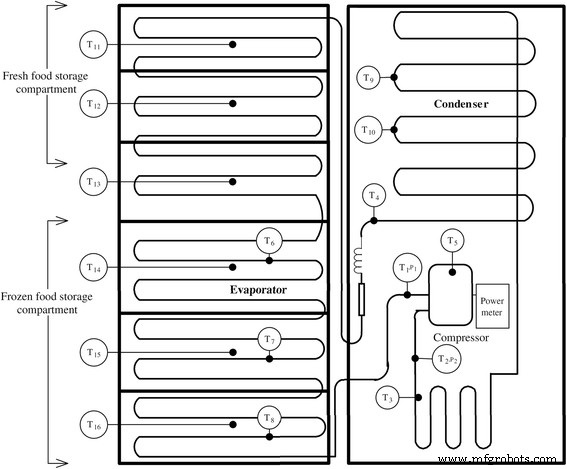
Schematic diagram of a domestic refrigerator with HFC134a, mineral oil and TiO2 nanoparticles [96]. Reproduced with permission from Elsevier
In addition, there is likewise a forward-looking study on the effect on the environment. Javadi and Saidur [103] observed that adding 0.1% of TiO2 nanoparticles to mineral oil-R134a could result in the maximum energy savings of 25% and reduce the CO2 emission by 7 million tons by year of 2030 in Malaysia.
It can be seen from Table 2 that the amounts of nanoparticles used in refrigerants were very low as below 0.1% [94,95,96,97,98,99,100,101,102,103], which can prevent clogging by the possible sedimentation of nanoparticles. However, although all results seemed positive, the long-term performance of the refrigeration system using nano-refrigerants is a great challenge.
Lin et al. [15] investigated the suspending ratio of (0.1 to 1%) nanolubricant–refrigerant after continuous alternation processes of condensation and evaporation. The schematic diagram and photographic view of their experimental system is shown in Fig. 8. They found that the degradation ratio was 28 to 73% after 20 times’ alternate operations. Also, they found lower particle loading can reduce the degradation speed. It can be concluded that the longtime performance of nano-refrigerant system is the essential step for further application in nano-refrigeration system.
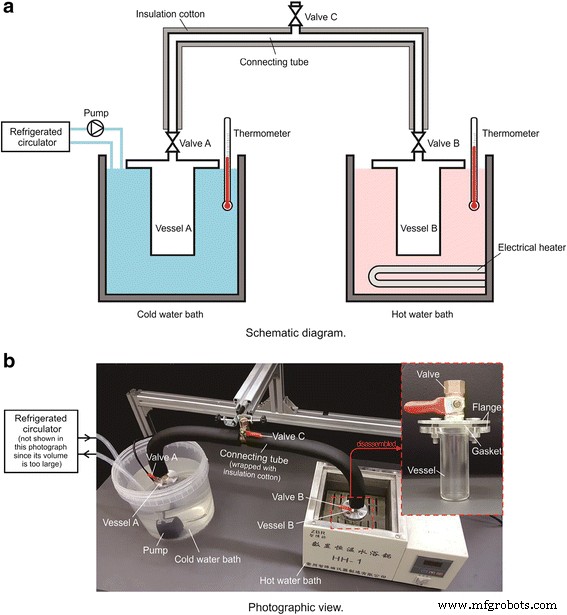
一 , b Experimental setup for condensation–evaporation alternation [15]. Reproduced with permission from Elsevier
Energy Storage
The storage of latent heat is through the most efficient mean of storing thermal energy. The conventional PCMs have a shortcoming of inadequate heat transfer performance which can reduce the rate of storing and releasing thermal energy. Therefore, some researchers have studied the method of improving the heat transfer performance by adding nanoparticles into PCMs.
Usages of PCMs mainly include energy storage of heating or cooling capacity. Research on cool storage application of TiO2 nano-PCMs is relatively rare.刘等人。 [104] find that thermal conductivity of saturated BaCl2 aqueous solution increases remarkably when adding a small amount of TiO2 nanoparticles. They found the thermal conductivity was increased by 15.65% as the TiO2 nanoparticle volume fraction was 1.13% at temperature of 15 °C. They thought this nanofluid is a good phase change materials (PCMs) with higher cool storage/supply capacity and rate compared with its base fluids, which exhibited good potential for being applied to cool storage as a substitute for conventional PCMs.
Another similar study was conducted by He et al. [105]. They also found the thermal conductivity of saturated BaCl2 aqueous solution can be distinctly enhanced by 12.76% when adding a small amount of TiO2 nanoparticles at −5 °C. Although decreases in the latent heat and specific heat and an increase in viscosity were found, those varieties have little effect on the cool storage system since the supercooling degree is reduced by 84.92%. They also thought that TiO2-saturated BaCl2 aqueous solution is suitable for low-temperature energy storage industries.
Studies on cool storage of TiO2 nano-PCMs are in the minority, while most PCM applications focus on the heat storage. Table 3 shows a brief summary on the thermal conductivities and the latent heat of TiO2 nano-PCMs for thermal storage applications in existing literatures. Sharma et al. [106] prepared a composite of palmitic acid (PA) and TiO2 nanoparticles with SDBS as dispersant for thermal energy storage application. The preparation steps of PA–TiO2 composites are shown in Fig. 9. It can be observed that the dispersion methods including adding surfactant, stirring, and ultrasonic vibration were implemented under the condition that the temperature of the base PA is above the melting temperature to confirm its liquid state.
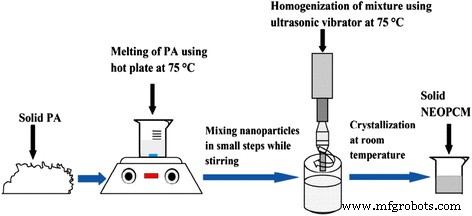
Preparation steps of PA–TiO2 composites [106]. Reproduced with permission from Elsevier
Their results showed that the thermal conductivity increased by 12.7, 20.6, 46.6, and 80% when the mass fractions of TiO2 nanoparticle were 0.5, 1, 3, and 5%, respectively. And they considered this PCM could be a good candidate as potential solar thermal energy storage materials due to its high latent heat and thermal reliability of palmitic acid. Harikrishnan et al. [107] dispersed TiO2 nanoparticles into PCM stearic acid and found this composite can accelerate the melting and solidification rates due to the enhanced heat transfer performance. They also observed that the addition of 0.3% nano-TiO2 nanoparticles can increase the thermal conductivity of stearic acid by approximately 63%. In their another research [108], they used stearic acid and lauric as base PCM and found an increment of 42% in thermal conductivity and a reduction of only 2% of latent heat of fusion. Motahar et al. [109] dispersed the TiO2 nanoparticles into organic PCM n-octadecane and found that the maximum enhancements of thermal conductivity in solid and liquid phases occurred at 3 and 4 wt.%, respectively. Moreover, the maximum average thermal conductivity enhancement for both phases was 26.6% when loading 5 wt.% nanoparticles.
Another experimental research focusing on the solidification process of PCM containing TiO2 nanoparticles was also performed by Motahar et al. [110]. They observed that the rheological behavior of liquid PCM–TiO2 at higher loading tends to Bingham fluids so that their solidification experiments were performed within 0–2.17 Bingham numbers. The results showed that the addition of TiO2 nanoparticles can enhance the thermal conduction process and hence increase the solidified volume. For particle mass loading of 1, 2, and 4%, the solidified volume fraction was increased by 7, 9, and 18%, respectively. At last, they proposed a universal correlation to predict the solidified volume fraction as a function of Fourier number, Rayleigh number, solid Stefan number, Bingham number, and particle loading.
Most of the results showed that when adding TiO2 nanoparticles, the thermal conductivity of PCMs can be greatly increased, while the latent heat will be decreased slightly, which is probably as a result of the thermal conductivity of nanoparticles which is much larger than the base composite, while the nanoparticles will not take part in the phase changing process as the base composite. However, in some case, both of the thermal conductivity and latent heat capacity of PCMs were considered to be elevated.王等人。 [111] prepared nano-PCMs by adding TiO2 nanoparticles into paraffin. They found the addition of TiO2 nanoparticles can change the phase transition temperature and latent heat capacity of paraffin. The phase transition temperature dropped with <1% loading, while increased with>2% loading of particles. The latent heat increased firstly and then decreased as the loading of particles increase. And the turning concentration is 0.7 wt.%, at which a maximum latent heat capacity can be achieved. While the thermal conductivity of the nano-PCMs increased monotonously with the loading of TiO2 nanoparticles. When the loading of TiO2 nanoparticles reached 7 wt.%, the thermal conductivity was increased by 13% but the latent heat was reduced by 9%.
Heat Pipes
The characteristics of boiling heat transfer and critical heat flux enhancement of nanofluids can be utilized in the heat pipe to improve its performance and broaden the application range. And some numerical results [112, 113] have shown that for thermosyphon heat pipe, using the nanofluid could achieve a better heat transfer characteristics. Also, some researchers have carried out related research using TiO2 nanofluids.
Zhou et al. [114] tested gravity heat pipes filled with DI water and TiO2 nanofluids, where the concentration and filling ratio of nanoparticles were varied and the initial temperature distribution was given. The result indicated that the heat pipes filled with nanofluids had a lower start-up temperature and a shorter start-up time in evaporation section under the condition of a water bath. And the biggest temperature drop between the evaporation section and the condensation section for heat pipes filled with TiO2 nanofluids was lower than those filled with DI water. The start-up time of heat pipes with filling ratios ranged between 50 and 70% in the evaporation section increased with the increase of the filling ratio and heating temperature, but the small inclination angle had a negative effect on the start-up performance.
Saleh et al. [65] collected data from different nanofluid experiments, where particle volume loading was up to 1.0% and the temperature of measurements ranged from 10 to 60 °C. They discovered that these data agreed with the classical Brownian motion theoretical model. They also investigated experimentally the effect of nanofluids on the thermal performance of heat pipes by measuring the wall temperature and thermal resistance distributions between the evaporation and condensation section. They found that distilled water and nanofluids achieved the best heat transfer performance when the inclination was set to 45° and the charge volume ratio of working fluid was 60%.
In 2015, Monirimanesh et al. [115] designed a thermosyphon-type heat pipe heat exchanger (HPHX) using TiO2 nanofluids as the working fluid to save energy in an air conditioning system. Their experimental apparatus was constructed as shown in Fig. 10. They establish a pre-cooling and pre-heating device to produce altered conditions of the inlet air for investigating the performance of HPHX. The evaporator and condenser section of the HPHX functioned as a pre-cooler and reheating coil for the air conditioning system respectively. They also employed an electric heater and electric boiler to supply heat and steam into the entered fresh air by a fan for the purpose of simulating the hot and humid climate. Their results showed that using TiO2 nanofluids and increasing the HPHX number of rows could make a part of air condensed on the evaporator fin, which could enhance the energy in the pre-cooling section. The use of 3 wt.% TiO2–methanol nanofluids in a four-row HPHX could achieve the highest energy savings ranging from 30.6 to 32.8% when the inlet air under the properties of 45 °C and 50–74% relative humidity. Based on a comprehensive consideration of the main purpose of supplying the energy required for reheating, they suggested that 2 wt.% TiO2–methanol nanofluid for the four-row HPHX would have been adequate and more economical.
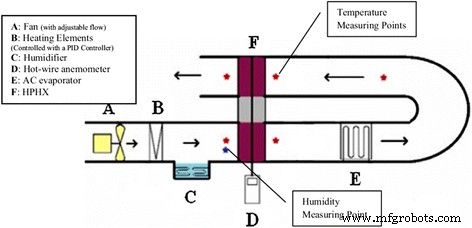
Schematic of the experimental apparatus [115]. Reproduced with permission from Springer
Mass Transfer
The mass transfer of nanofluids is another important application aspect of TiO2 nanofluids. Current research has shown that TiO2 nanofluids can be used to enhance the absorption process of CO2 and NH3 as well as the mass transfer coefficient of electrolyte fluids.
李等人。 [116] prepared stable N -methyldiethanolamine (MDEA)-based nanofluids to strengthen the absorption performance of CO2 in the MDEA solution. The CO2 absorption characteristics in the gas/liquid interface of nanofluids were investigated by measuring the absolute pressure drop of gas. The mass fraction of MDEA was 50%. And they used two particle mass fractions of 0.1 and 0.4%. The results showed that the CO2 absorption rate increases with increasing temperature and it is enhanced by the added nanoparticles. However, at 20 and 30 °C, the enhancement caused by the mass fraction of nanoparticle (0.1 and 0.4%) reduced gradually. The effective absorption ratio varied from 1.03 to 1.14. Also, CO2 bubble absorption ratio increased with the increase of nanoparticle mass fraction.
Yang [117] prepared stable TiO2 nanofluids without adding dispersant and then carried out a comparative experiment on the falling film performance of absorption of ammonia gas by nanofluids and pure water. The schematic diagram of the experimental system for NH3–H2O nanofluid falling film absorption is shown in Fig. 11. They found that the absorption rate of ammonia gas can be increased by 10% when adding anatase TiO2 nanofluids. Wu [118] used the similar experimental device but changed the falling film tube of Fig. 11 into a fin tube. He investigated the effect of rutile TiO2 nanofluids on the ammonia absorption performance of falling film outside a fin tube. The result showed that the combined use of zigzag tubule and TiO2 nanofluids can strengthen the ammonia–water falling film absorption and the maximum increment can reach 60.8%.
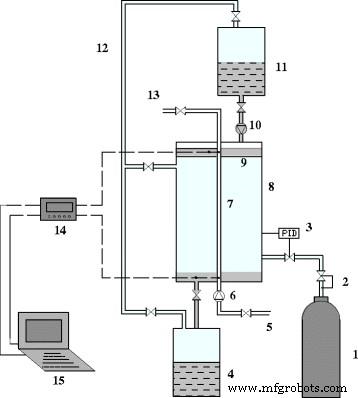
Schematic diagram of the experimental system for NH3–H2O nanofluid falling film absorption [117]. 1 NH3 vessel, 2 decompression valve, 3 constant pressure controller, 4 , 11 container of solution, 5 inlet of cooling water, 6 , 10 constant flow controller, 7 falling film tube, 8 visible absorber body, 9 solution distributor, 12 tubes for balancing pressure, 13 outlet of cooling water, 14 HP data acquisition instrument, 15 computer
Beiki et al. [119] investigated experimentally the turbulent mass transfer characteristics of TiO2 and γ-Al2O3 electrolyte nanofluids in a circular tube. The results showed that adding 0.015 vol.% TiO2 and 0.01 vol.% γ-Al2O3 could bring an increase in mass transfer coefficient of the electrolyte solution by 18 and 10%, respectively. They found that the enhancement ratio was independent of Reynolds number. The mass transfer coefficients increased firstly and then decreased as the nanoparticle loading increase. They attributed the cause of the existing of optimal particles’ loading to the clustering of nanoparticles and forming bigger agglomerates with smaller Brownian velocity when exceeding the optimum loading.
Coolant of Milling
As a coolant, nanofluids’ heat transfer enhancement characteristic can improve the cooling performance [120]. Moreover, when nanofluids are used for milling, another characteristic of nanofluids viz. enhancement in wear resistance can also play an important role in extending the lifetime of the milling tool.
Yogeswaran et al. [121] investigated experimentally the effects of coolant of TiO2–EG nanofluid on the tool wear and workpiece temperature at the various milling conditions when used for milling a stainless steel AISI 304. The milling tool was made of a TiN-coated carbide insert. The results showed that comparing to pure base fluid, the workpiece temperature was reduced by 30% when using the nanofluid as coolant. The tool wear from milling using the EG-based TiO2 nano-coolant is much less than using the normal commercial coolant because the nanofluids can reduce the heat penetrating into the inserts. And the tool life is increased as a result of the nanoparticles reduces the damage on the edge of the tool.
Muthusamy et al. [122] also compared the efficiency of nanoparticle-based coolant (TiO2–EG) and conventional water-soluble coolant on the tool life and wear performance of a TiN-coated carbide insert in the end-milling process of AISI304 stainless steel. The results showed that using TiO2–EG nanofluid as coolant could increase the tool life from 32.67 to 54.9 min (increased by 40.55%) comparing to that using TiO2–EG nanofluid as coolant instead of water-soluble coolant. They attributed the cause to a Ti nanoparticle layer on the edge of the insert formed during the milling process when using TiO2–EG nanofluid, which can be proved from the SEM and EDX of cutting edge as shown in Fig. 12. When using nanofluids as coolant, the oxidation still occurred despite the cutting temperature was reduced at the interface of the tool and workpiece since it can be found from Fig. 12 the O peak on the EDX spectrum. The hard oxidation layer was formed due to the entering of oxygen from TiO2–EG nanofluid into the tool–workpiece interface. Then, the hard oxidation layer can protect the tool from micro-cracking and chipping wear because it could not be easily detached despite under the severe impact of the milling force and took parts of the tool surface from the workpiece.
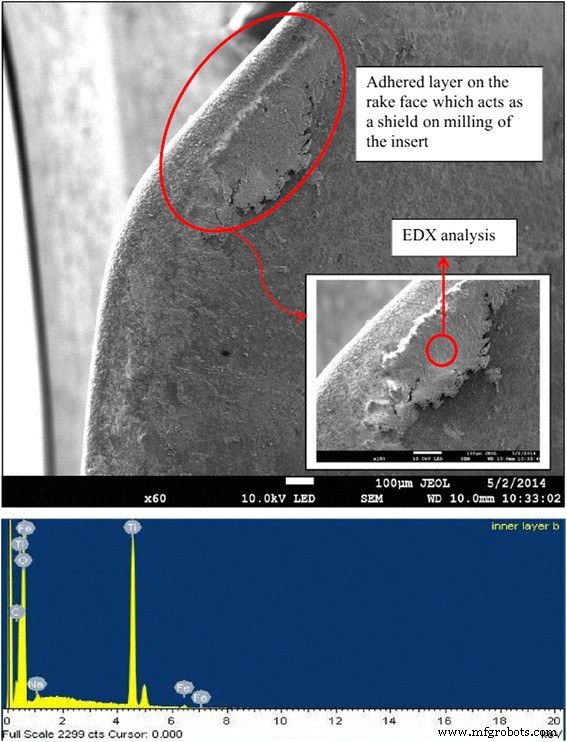
SEM and EDX of cutting edge [122]. At a cutting speed of 1500 rpm, feed rate of 0.02-mm tooth, and axial depth of 0.1 mm using nanoparticle-based coolant at a cutting distance of 180 mm (×60 magnification). Reproduced with permission from Springer
Challenges and Future Works
Challenges
The above energy-related examples have exhibited the extensive application prospect and excellent properties of TiO2 nanofluids. Although in some cases, especially in heat transfer applications, the heat transfer performance of TiO2 nanofluids are not better than that of Ag, Cu, and CNT nanofluids, TiO2 nanofluid is also a good choice due to their comprehensive properties for instance better dispersion and chemical stability, security, and economy.
Although TiO2 nanofluids have showed great enhancement in heat transfer of solar collectors, refrigeration, energy storage, heat pipes, and coolant of milling, the investigations on the performances including dispersion stability and heat transfer performance after running operations are in great lack. Most dispersion stability studies are in static conditions, but it is important that the nanofluids prepared should be treated in the practical application conditions to examine the dynamic cycle stability and the sustainability of both system performance and components of nanofluids.
Generally, the biggest downside in application of nanofluids is the sedimentation and degeneration of nanoparticles after long running which makes the long-term performances of nanofluid system challenged. Some researchers have proposed a new idea and a novel method to re-disperse the aggregates in real time of the running system [123]. However, the concrete effect of the device has to be verified experimentally, and then, the design and location of the re-dispersion device needs to be improved. The surfactant is expected to have positive effect on the re-dispersion characteristic of aggregates. However, one of the biggest flaws in using surfactants is the occurrence of foaming when the fluids are under flowing or heating conditions which would have adverse impacts on the heat or mass transfer application of nanofluids. This defect suggests the amount of surfactant employed in the nanofluids should be limited.
Another great limitation in application of nanofluid is the increase in pumping power and pressure drop of nanofluids, which is essential for the high-quality application of solar collectors, refrigeration, and heat pipes. For instance, Sajadi and Kazemi [124] found the proportional increase in pressure drop of TiO2 nanofluids is higher than that of heat transfer coefficient. While Teng et al. [125] found the pressure drop proportion of TiO2 nanofluids for turbulent flow is lower than that for laminar flow. Therefore, if the extra energy consumption by the increased viscosity of nanofluids exceeds the benefit from the heat or mass transfer enhancement, there will be no application prospect. The most extreme case is when a large amount of agglomerations emerge, the pumping power and pressure drop of nanofluids will be greatly increased, which might lead to serious impact on system performance. Moreover, based on the similarity principle in heat transfer study, for instance in forced convection process, Nusselt number is determined by Reynolds number and Prandtl number, different thermal conductivity and viscosity will induce different Nu even though for the same experimental heat transfer coefficient. Therefore, the properties of nanofluids are essential for quantitative study in those application fields.
Future Works
As a widely used material in considerable fields, TiO2 has been explored several hundred years, and its nanofluidic form is also firmly worth studying and expected to make greater contributions owing to the outstanding physical and chemical properties. This paper provides a summary of the research outcomes of TiO2 nanofluids up to now, including the preparation and stability of TiO2 as well as three vital properties of TiO2 nanofluids. It can be concluded that TiO2 nanofluids show very comprehensive applications in heat transfer or other energy fields due to their good dispersion stability in both hydrophilic and lipophilic liquids, nontoxic and non-corrosive natures, chemical stability, lower price, and good appearance. Therefore, TiO2 nanofluid is thought as one of the closest kinds to practical industrial application environment because of their better dispersion and chemical stability, security, and economy.
However, although TiO2 nanofluids have shown enormously exciting potential applications, before commercialization of nanofluids, some urgent problems are summarized as follows:
Firstly, acquiring high-quantity nanofluid with outstanding long-term and high-temperature stability is the fundamental of the entire research since in any practical application, it is essential to have a stable suspension.
Secondly, the way to enhance and keep the stability of nanofluids in real time is a key issue in the actual use since the sedimentations of nanoparticles seem inevitable after a long-term running. The method to re-disperse the aggregation of nanoparticles in real time by adding some dispersion device in the system with functions of ultrasound or agitation might be a useful option [123].
Thirdly, although the surfactants were used to improve the dispersion and adhesion performance of nanoparticles in liquid, the effect of surfactants on the physical properties and system performance needs to be investigated. The amount of surfactants should be investigated experimentally owing to the positive and negative effects of surfactants.
Fourth, the pumping power or pressure drop of nanofluids is another challenge for the engineering application. Using nanofluids with higher viscosity than base fluids will induce a higher pressure drop and hence needs more pumping power [125]. The method to achieve higher heat transfer coefficient and lower pressure drop needs to be further studied.
Fifth, the waste management of the invalid nanofluids should also be considered when applying them to industrial systems. The impact on the environment by the nanofluids restricts many kinds of nanofluids containing heavy metal, toxic substance, or other hazardous substances. The super whiteness dyeing behavior of TiO2 nanofluids should also be noticed to prevent the environment getting contaminated.
Sixth, although some studies have analyzed the entropy generation in tubes [126], microchannels [127], sheet, and other types of flow [128, 129], the entropy generation characteristic of nanofluid in the full system is actually the most important parameter for the full-system application or designing.
Last but not least, there is lack of evaluation index on the performance of nanofluids, especially on the stability, adhesion, and property sustainability of nanofluids. There is no unified indicator to evaluate the stability and adhesion of nanofluids. The uniform evaluation indexes on the different properties of nanofluids are needed [130].
The above problems are urgently needed to solve for the further application of TiO2 nanofluids, which point out the directions of the future works in this field. It is believed that these problems and challenges will be solved or reduced with the development of nanofluid technology in the future.
Conclusions
This second part of the review summarizes recent research on application of TiO2 nanofluids and identifies the challenges and opportunities for the further exploration of TiO2 nanofluids. It can be concluded that although particle loading has exhibited a positive correlation with thermal conductivity of nanofluids, the effects of other factors including particle shape, size, base fluid type, temperature, surfactant, and sonication are unified. Even for particle loading effect, the intensities of growth in thermal conductivity differ widely for different samples. TiO2 nanofluids have shown good applications in many energy-related filed. However, the indeterminacy of long-term performances for both nanofluid and system and the increment in pressure drop are needed to investigate for further application. The forecast research hotspots are regarded as the long-term and high-temperature stability and re-disperse the aggregation of nanoparticles in real-time system, the required amount of surfactants, the heat transfer and pumping power characteristics, and the evaluation index on the stability, adhesion, and property sustainability of nanofluids.
纳米材料


